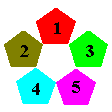As a rule of thumb universities are not a source for the actual Methodology of Creative (and error-researched) Thinking.
The coarse structure of morphological methodology comprises three elements:
This is unfortunate, because thinking behavior influences innovation ability, social behavior, and ethics in the work place. Following Zwicky, who considers Methodology of Creative Thinking to be a self-contained discipline called General Morphology, it becomes clear, that methods must be classified and their relationship in application must be shown.
1.
Free wheeling of thoughts. Let intuition run without interference. Your own, your partner's, everyone is granted the right to present thought as they happen. No disqualification if the idea is not the stupendous one. Trying to guess the result - intuitive idea research.
2.
Careful testing of an intuitive idea. Be warned about unqualified rejection. The goal of unqualified rejection is to end the dicussion of a contra-intuitive idea, without carefully researching it first. Too many people are mixing up such "criticism" with a critical testing process. Careful critical research demands the highest intellectual competence. Warning: Never disqualify someone for producing a thinking error. The proper approach is to help the person with the methodology of researching thinking errors.
3.
If intuition is stuck and no new ideas are being produced, neither on the subject nor about idea testing, then mentally move away from the problem. Change the subject of your thoughts to the researching of the methods of the thinking process, the so far obtained results, and the conclusions. Systemize these (put into an orderly pattern or relationship) - developing the Methods-Research process.
 |
The core of the morphological methodology consists of a harmonious system of creative thinking in orderly form. The logo of the Morphological Institute Canada indicates these relationships. |
Every single person - being in a creative thinking process - is using the brain, the spirit. Facts are:
 |
The brain arrives with an immense development potential - everyone a genious. |
 |
The brain arrives without warranty certificate - thinking errors slip through without being caught. |
 |
The brain is delivered without user manual. - It is setup in "Intuition Cruise Control Mode". The real power of the brain can be accessed when the Cruise Control is turned off during situations of high demand. High demand meaning a Creative Challenge - when routines won't do. |
The five elements indicated by CanMor's logo point to the following core zones of Creative Morphological Methodology, which all influence each other:
| 1. | The mind. Typical referals are attitude, composure. The more subtle dimensions are how the mind formulates and absorbs advice, irritant information (new, counterintutitive ideas, risk), how it handles mental stress, etc. |
| 2. | Communication. Body talk and vocal communication, written word, language confusions and preconceivements form part of the communiation patterns. A further important (seminar) part is error and behavior research in communication, feedback, safety and stress signalling, inducing and controlling fear, etc. |
| 3. | Organizations, their structure and power flow patterns have an immense influence on Creative Thinking. The efficiency of an organization depends on the attitude of the organization, its ability to adopt new, or at least appropriate methods on any process that influences the organization itself. Loose or chaotic, guided or dictated, all these ways of behavior influence the whole system. |
| 4. | Thoughts are processes. Processes in our work environment are results of thought. Never mind whether we are concerned with processes of thinking and researching, or with processes in manufacturing and marketing, and guiding the company. Like other processes, thinking processes must be understood, their characteristics and parameters research for side effects which might harm the objectives. |
| 5. | Methodology in thinking, researching must be understood in the same way as the language of mathematics must be understood to convey a mathematical thought. Wrong methods tend to produce the wrong result. Methods research will show whether the conclusions are based on a sound methodological approach. |
 |
Understanding thought processes using the creative morphological approach right here differs from the psychological approach. Psychology is concerned with reaction. Creative Morphology (when concerned with the brain) studies reaction and action and becomes active in formation of new thinking processes as a whole - replacing unsuitable ones (overdriving cruise control). Before we apply the Creative Morphological Approach to manufacturing, product and process development, etc., we must be sure the brain's own processes are working well. See main menu for specific pages. |
 |
The Goal of Creative Morphology: To structure creative thinking processes methodically. |
 |
The Objective of CreativeMorphology: To create integral systems. Systems which are free of coarse thinking errors, and which will not produce results due to thinking catastrophes. (Catastrophes challenge survival) |
 |
The Sense of General Morphology: To deliver a useful contribution to the survival and development of humanity. |
Source: Extracted from a presentation (1983.12.8.) at Physikzentrum Bad Honnef, of Deutsche Physikalische Gesellschaft, during a conference Forschungsmanagement in der Physik VIII - Research management in Physics. By Hermann Holliger, Morphological Institute Zurich, President of Certified Management Consultants (ASCO), Switzerland.
Extracted, adapted, and translation: Emil Zahner
Email: get email address